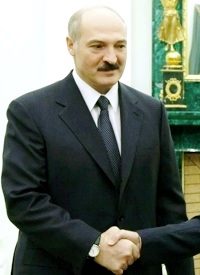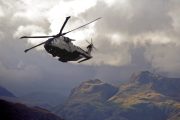
The European Union announced today that they would be reinstating a travel ban against Belarusian President Alexander Lukashenko and 40 of his close associates, following his crackdown on political opponents in the country’s elections, which were held on December 19, 2010.
December’s elections, like all other elections during Lukashenko’s reign, are believed to have been rigged, and violence, suppression of dissenters, and intimidation are all well-documented tactics the (former) Soviet agricultural commune director, Soviet Army and Border Patrol officer, and Komsomol (Communist Union of Youth) Chapter Director has employed in guaranteeing his sustained power grab.
The travel ban was reinstated due to Lukashenko’s sustained repression on his political opponents and on the media following December’s elections. A previous ban for the same reasons was earlier placed on Lukashenko, but later repealed in 2008, after he promised reforms. Lukashenko “won the election” with 79.67% of the vote, despite his “running against” almost twenty opposition candidates, most of whom withdrew candidacy bids after pressure was put on them by Belarusian police. All nine opposition figures who made it on the ballot received, together, less than half the total votes garnered by Lukashenko, a prognostication made by the country’s Central Election Committee which was proven true by the results of the pseudo-election.
Lukashenko’s most formidable and potent political opponents were the subject of violent attacks on the occasion of the country’s elections. Candidate Uladzimier Niaklajeu was beaten by government militia forces on Election Day, and seven other opposition candidates were arrested by police, detained, and beaten, along with hundreds of the 40,000 Belarusians who protested Lukashenko’s tactics, whom Lukashenko called “hooligans, vandals, and beasts.” (His government claims that only 639 protesters were detained, while human rights advocates contest this.)
Those who dared protest against Lukashenko were charged by the State Security Agency of the Republic of Belarus (which still goes by the name KGB), which announced that 600 activists could be imprisoned for up to 15 years.
Belarus is cited as Europe’s worst country for freedom of the press, and Lukashenko’s KGB has forcibly searched and seized the property of journalists and opposition leaders. Dozens of other journalists have been beaten, imprisoned, and in one case, even murdered by the regime, which dismissed it as a “suicide” due to the victim’s “mental instability.” Opposition candidates also report being blocked out of social media websites by the state’s Interior Ministry.
The United States, the European Union, and the Organization for Security and Cooperation in Europe (OSCE) have each condemned the election results as illegitimate due to the draconian means by which Lukashenko was reelected. The OSCE report found that the elections once again fell short of being fair and transparent. In response to OSCE criticism, Lukashenko shut down their Minsk office, claiming that there was no reason for OSCE activities in Belarus, which asserts that their elections were democratic, and even published false reports claiming that the OSCE acquiesced to this claim.
The Commonwealth of Independent States (CIS) and their member states, along with Venezuela (which has promised Lukashenko “100 years of oil”), Communist Vietnam, Red China, and Syria have each accepted the elections as legitimate and offered congratulations to Lukashenko.
Lukashenko is described as “Europe’s last dictator” of Belarus, a country which former U.S. Secretary of State Condoleezza Rice described as “the last true remaining dictatorship in the heart of Europe.” The CIA’s “World Factbook” states that Lukashenko has “steadily consolidated his power through authoritarian means,” and points to the resurgence of the USSR, as Belarus has retained closer political and economic ties to Russia than any of the other “former Soviet republics.”
This is most evident in Lukashenko’s proposed formation of a Union State in 1999, which would effectively combine Belarus and Russia into one Soviet Union-style federated entity, with a common president, parliament, flag (which is essentially the same as the USSR flag, merely replacing the iconic hammer and sickle symbol of communism with two gold stars representing Russia and Belarus), currency, anthem (using the same music as the Soviet Union’s National Anthem, like the present anthem of the Russian Federation, albeit with different lyrics), army, citizenship, and constitution. Both the Duma and the Belarusian National Assembly voted on forming the Union State in the winter of 1999-2000, and it is the clear predecessor of the Customs Union formed by Russia, Belarus, and Kazakhstan, previously reported by The New American.
Lukashenko’s own Union State endeavor was supported earlier by Kazakh President Nursultan Nazarbayev, who as early as 1994, proposed the creation of a “Eurasian Union,” which would unify Russia and all Central Asian republics into a single economic state, cleverly dubbed “post-Soviet integration” by Nazarbayev, whose Prime Minister, Karim Masimov, says that Kazakhstan’s relationship with Russia is “best, from the standpoint of integration,” as there are “practically no barriers between us,” which he stated in an interview with Russia’s Kommersant newspaper.
Masimov led a widespread propaganda campaign in favor of the Customs Union throughout rural regions of his country, where many oppose the creation of supranational entities with Slavic states, and according to an article in Asia Times, President Nazarbayev’s former advisor, Yermukhanbet Yertisbayev, has boasted of the fact that the joint Belarusian-Russian-Kazakh endeavor “indicates that Kazakhstan and Russia were successfully moving along an integration course towards the restoration of the Soviet Union.”
Lukashenko was also a signatory to the Eurasian Economic Community (EAEC) Treaty of October 10, 2000, which established freedom of movement and a more unified economy between Russia, Belarus, Kazakhstan, Tajikistan, and Kyrgyzstan (the EAEC member states officially became a single market when Common Economic Space was announced on January 1, 2010). The (former) Soviet states Armenia (whose capital city, Yerevan, declared Lukashenko an “Honorary Citizen” in 2001, and with whom Lukashenko has enormous economic ties, as numerous Belarusian enterprises manufacture in Armenia, including the Belarusian-Armenian Trade House, which he “ordered to establish in 2009,” according to Armenian news sources, Moldova, and the Ukraine (whose leader, Viktor Yanukovych, has pledged great bilateral cooperation with Russia, has suppressed free media expression, and was a former boss in the Communist Party) each have observer status within the EAEC, and Yanukovich has announced his intentions to also join Lukashenko’s Union State.
Also expressing interest in joining the Union State was Serbia, which previously was not a member of the Soviet Union. Serbian President Tomislav Nikolic, who is leader of the country’s Progressive Party, whose platform calls for “social justice,” as well as former leader of the Serbian Radical Party (a group with its roots in the pro-Axis Chetnik forces of World War II, formerly aligned with the Serbian Socialist Party as a fellow coalition partner, and home to Slobodan Milosevic-linked war criminals, such as Vojislav Seselj, who was also one of the youngest-ever admitted leaders in the League of Communists of Yugoslavia-SKJ), has ties with Lukashenko, and on May 5, 2007, he met with Russian Ambassador Aleksandr Alekseyev, arguing in favor of Serbia’s membership in what he described as the “Russian-Belarusian super state.”
Nikolic, a vitriolic anti-Western leader, pledged Serbian allegiance to the Union State, according to Radio Free Europe and Serbia more recently has received critical unconditional support from Belarus and Russia on Kosovo. In addition, in 2008, Serbia has sent many children aged 11-15 to Russia for military training in firearms and grenade-throwing in a facility operated by the nationalist, white-supremacist group “Styag,” which is backed by Lukashenko and Lukashenko has engaged in broad bilateral relations with Serbia, on both cultural and economic grounds, including free trade agreements which provide for the employment of Serbs in Belarus, according to Radio Srbija.
The stance taken by Belarus and Russia toward Serbia is incidentally the same policy toward Serbia taken by numerous communist leftists abroad. Milosevic, former leader of the Serbian Socialist Party and head of the ideology committee of the Yugoslavian Communist League’s student branch (SSOJ), whose ascendancy to genocidal prominence was facilitated by the 1987 Eighth Session of the League of Communists of Serbia, was defended by a variety of communist-affiliated groups, the Workers World Party of the USA (which also defends North Korea and Saddam Hussein), the Wisconsin Committee for Peace and Justice, Ramsey Clark, and Michael Parenti, “Progressive Journalist” who has been praised by such figures as Cornel West and the New York Times Book Review for his stances, which include opposing “NATO imperialist demonization of Milosevic,” as well as accusing Tibetan Buddhists of violence and pedophilia while acting as “CIA agents” opposing the “social reforms of the Chinese Communist Party.”
Belarus, therefore, is a clear example of the Soviet Union having never actually disappeared, but persevering amid being repackaged into new, deceptive, and even expansive forms, such as supranational organizations along the lines of the EAEC and the Union State.
Belarus is truly the last Soviet republic, a contention made by British philosopher and researcher Stewart Parker, in his critically-acclaimed book The Last Soviet Republic: Alexander Lukashenko’s Belarus, as well supported by Lukashenko’s domestic policies, which are the precise reason for the reinstatement of the ban against his entry into EU-member states.
Photo: Belarusian President Alexander Lukashenko shakes hands with Russian President Dmitry Medvedev (out of picture) in Moscow’s Kremlin on Dec. 22, 2008: AP Images


